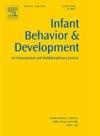Infants’ attraction to infant vocalizations – A catalyst for infant development
IF 2
3区 心理学
Q3 PSYCHOLOGY, DEVELOPMENTAL
引用次数: 0
Abstract
Infant vocalizations play a key role in infant behavior and development, yet we know very little about how infants perceive speech signals with infant vocal properties. In this perspective paper, we summarize recent developmental studies capitalizing on technical breakthroughs in speech synthesis that have allowed for rigorous exploration of this topic. The findings indicate that infants prefer to listen to speech signals with vocal resonances that specify a small, infant-sized vocal tract; this preference is robust and distinct in some ways from infants’ attraction to infant-directed speech. This infant talker bias may support infants’ speech recognition skills and there is growing evidence that it is also tied to infants’ own emerging vocal production abilities. These findings further validate prominent views of speech development, including the articulatory filter and the analysis-by-synthesis hypotheses. Related work in our lab shows that adults also display a strong attraction to infant vowel sounds, adding weight to calls for an expanded and multimodal infant schema. Converging evidence that both infants and adults find infant vocalizations appealing also provides critical support for the fitness-signaling perspective on infant endogenous vocalization. We argue that the infant talker bias has a positive impact on multiple levels, shaping receptive, expressive, and motivational aspects of infant development. The infant talker bias also plays a central role in caregiving behaviors and infant-directed speech. The perceptual potency of infant speech is a catalyst for infant development and also for meaningful and innovative research.
婴儿对婴儿发声的吸引力——婴儿发展的催化剂
婴儿发声在婴儿行为和发育中起着关键作用,但我们对婴儿如何通过婴儿发声特性感知语音信号知之甚少。在这篇前瞻性的论文中,我们总结了最近利用语音合成技术突破的发展研究,这些研究允许对这一主题进行严格的探索。研究结果表明,婴儿更喜欢听带有声音共振的语音信号,这些声音共振指定了婴儿大小的小声道;这种偏好在某些方面与婴儿对婴儿指向语的吸引力是明显不同的。这种婴儿说话者的偏见可能支持婴儿的语音识别技能,而且越来越多的证据表明,这也与婴儿自身正在形成的发声能力有关。这些发现进一步验证了语言发展的突出观点,包括发音过滤和合成分析假说。我们实验室的相关工作表明,成年人也对婴儿元音表现出强烈的吸引力,这增加了对扩展和多模态婴儿模式的呼吁。越来越多的证据表明,婴儿和成人都认为婴儿发声具有吸引力,这也为婴儿内源性发声的健康信号观点提供了重要支持。我们认为,婴儿说话者偏见在多个层面上都有积极的影响,塑造了婴儿发展的接受、表达和动机方面。婴儿说话者偏见在照顾行为和婴儿指向语中也起着核心作用。婴儿言语的感知潜能是婴儿发展的催化剂,也是有意义和创新的研究。
本文章由计算机程序翻译,如有差异,请以英文原文为准。
求助全文
约1分钟内获得全文
求助全文
来源期刊

Infant Behavior & Development
PSYCHOLOGY, DEVELOPMENTAL-
CiteScore
4.10
自引率
4.80%
发文量
94
期刊介绍:
Infant Behavior & Development publishes empirical (fundamental and clinical), theoretical, methodological and review papers. Brief reports dealing with behavioral development during infancy (up to 3 years) will also be considered. Papers of an inter- and multidisciplinary nature, for example neuroscience, non-linear dynamics and modelling approaches, are particularly encouraged. Areas covered by the journal include cognitive development, emotional development, perception, perception-action coupling, motor development and socialisation.
 求助内容:
求助内容: 应助结果提醒方式:
应助结果提醒方式:


